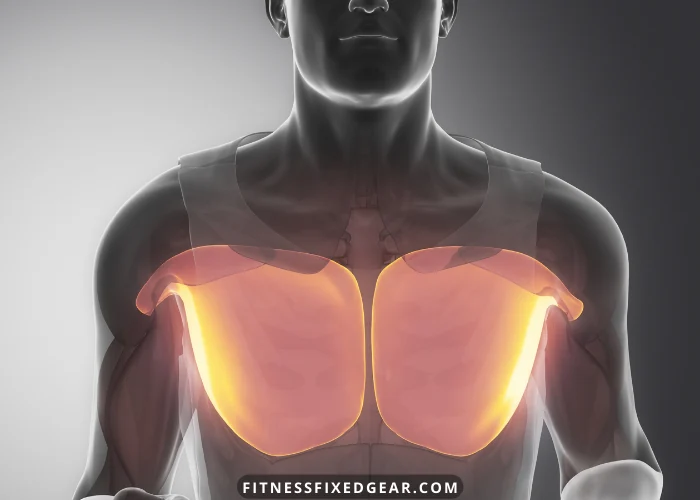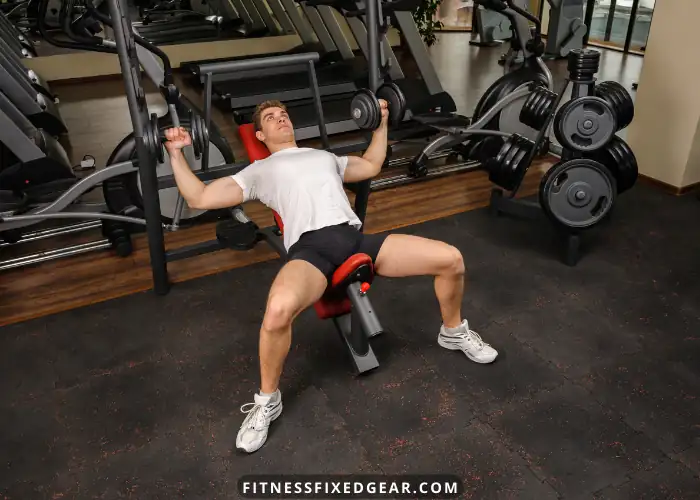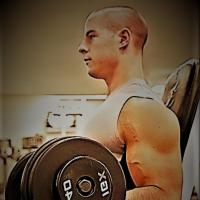The bench press is a staple in most strength training programs, and for a good reason — it effectively targets big upper body muscles (more on exactly which muscles below).
But what if you don't have a weight bench? Or you don't have one that inclines? Or do you only have dumbbells, or have hit a plateau in your press?
If that's the case, then the 10 best incline bench press alternatives are:
- 1. Reverse Grip Dumbbell Presses
- 2. Cable Incline Flys
- 3. Lever Incline Chest Presses
- 4. Incline Dumbbell Presses
- 5. Barbell Floor Presses
- 6. Decline Push Ups
- 7. Low to High Cable Flys
- 8. Dumbbell Decline Bench Presses
- 9. Chest Dips
- 10. Dumbbell Pullovers
But first...
What Is the Incline Bench Press?
Hopefully, you're familiar with the standard bench press: you lay on your back on a weight bench, barbell supported above you, you lift it off the pegs, lower it to your chest, and press it back up.
An incline bench press does the exact same movement, except your upper body is on, well, an incline. To achieve this, you usually need a flat bench that can turn into an incline bench.

Why would you do an inclined bench press? Because it works more of your upper chest, specifically, your upper pecs (more on that below).
TL;DR: An incline bench press is a standard bench press done on an incline. Duh!
What Muscles Does an Incline Bench Press Work?

You likely already know that an incline press works your chest muscles, specifically, your upper chest muscles. To get technical for a moment, the muscles worked are:
- Target muscles: pectoralis major, clavicular (upper pecs)
- Supporting muscles: pectoralis major, sternal (mid pecs); anterior deltoids (fronts of your shoulders); triceps brachii
- Stabilizer muscles: biceps brachii, short head (the main muscle people think when they hear "biceps")
There's also a bit of work being done by your core muscles, as you need to keep yourself balanced and your core engaged during the move, but those aren't the key muscles used.
TL;DR: Want a solid upper body workout? An incline chest press targets your pecs, shoulders, and arms in one movement.
What Makes a Great Incline Bench Press Alternative?
Any solid incline bench alternative will work the same muscles as the incline bench. That means it will target your upper chest, shoulders, and upper arms.

So whether you use a DIY incline bench, push ups, a Swiss ball dumbbell press, or any of the exercises on this list, as long as you're getting that upper chest activation that's similar to the incline bench press movement, you're good to go.
TL;DR: An effective incline bench press alternative will use the same muscles as the incline press itself.
The 10 Best Incline Bench Press Alternatives
Without further ado, let's dig into my top picks for an incline bench press alternative!
1. Reverse Grip Dumbbell Presses
A reverse grip dumbbell press is essentially doing a bench press but 1) using dumbbells and 2) holding them in a reverse grip (meaning your palms face you).
Holding the dumbbells this way targets the upper chest the same way that doing an incline bench press does, without the need of the incline.
(The video also shows you a similar movement pattern called a grip rotational dumbbell press or an Arnold chest press.)
Equipment Needed
- A set of dumbbells
How To:
- Select your weight of choice and lay back on your bench. If you're lifting particularly heavy, use your thighs to "kick" the dumbbells up and into starting position over your chest.
- With your feet flat and firmly planted, holding the dumbbells with palms facing you, take a deep breath in and brace your core.
- Lower the bells down toward your chest, keeping your elbows close to your sides. At the bottom, pause for a moment and imagine hugging the bench with your shoulder blades. You should feel a gentle stretch through your upper chest muscles.
- Exhale as you press the dumbbells upwards to starting position.
Pro Tip:
Use a slower tempo and lighter weight, especially at first, so you can really focus on contracting your shoulders and triceps throughout the movement.
2. Cable Incline Flys
This bench press alternative does require access to a cable machine, but if you've got one, it's a killer move for your upper chest. (If you don't, check our cable crossover alternatives list)
The difference between a bench press and a fly is one of form: in a bench or chest press, you start with your arms straight above you and then bend your elbows down to about a 90º angle.
In a chest fly, you maintain a slight bend in your elbows the entire time. Plus, when doing them with a machine, you have a neutral grip, meaning your palms face each other.
Equipment Needed:
How To:
- Load your cable machine with an appropriate weight (begin lighter than you think you can do). Set your flat bench to a comfortable incline (or use an incline bench) and place it directly in the center of the cables.
- Pick up one D-handle and sit down on your bench. Pick up the other D-handle (alternatively, have a spotter hand you the handles). Keep your back pressed firmly into the bench and your feet pressed firmly into the floor.
- Exhale as you bring the rings together over your chest. Make sure to maintain that gentle bend in your elbows, like you're hugging a tree. Keep your core braced.
- Inhale to lower the weights back out, being careful not to lower your arms past your chest.
Pro Tip:
Don't have access to a machine? You can do this move with dumbbells, too.
3. Lever Incline Chest Presses
A lever incline chest press is a great incline bench press alternative for those who have access to a gym. It uses the hammer strength machine, which you typically don't find in a traditional home gym.
Equipment Needed:
How To:
- Place your desired weights on the outside of the machine. Adjust the seat so when you sit down, the weights are about nipple height. Keep your head back against the incline bench and your feet firmly planted. Make sure your elbows aren't hiked up but instead are rather low, beside your rib cage (you're pushing up, not forward).
- With wrists straight and a neutral spine, keep your core tight and exhale as you press the handles up and away from you. Keep your elbows pointed down.
- Inhale as you return your elbows to about a 90º angle.
Pro Tip:
This makes the list of our incline bench press alternatives because it removes almost all the stabilization requirements, meaning it really targets your upper chest.
4. Incline Dumbbell Presses
Dumbbell exercises are vastly underrated. You can easily get a solid workout using two dumbbells, just as much as a barbell or with machines. So whether you use adjustable dumbbells or traditional ones, this move is for you.
Equipment Needed:
How To:
- Set your bench to the desired incline. Choose your dumbbells and, if they're heavy enough, use your thighs to "kick" them up as you lay back on the bench. Begin with your adjustable dumbbells low so your elbows make an approximate 90º angle.
- Keep your shoulders "peeled back" meaning tucked underneath you slightly. This should give you a natural arch in your low back but you should maintain contact on your upper back, glutes, and feet.
- Exhale as you press the dumbbells upwards. Don't flare your elbows or tuck them in too close, but keep them at a comfortable about 45º angle.
- Inhale as you lower the dumbbells back down.
Pro Tip:
The incline of the bench will determine which chest muscles you target. A steeper incline targets your upper chest and shoulders more, whereas a lower incline targets your lower chest.
5. Barbell Floor Presses
Have a barbell but no incline bench? No problem!
Enter the barbell floor press. It's a stellar way to help you break through any sticking points you may have and potentially boost your bench press PRs (personal record).
Plus, like all these exercises, it targets those coveted upper chest muscles.
Equipment Needed:
How To:
- Load your barbell and set it on your risers (this gives you space to get underneath the bar and keeps you safe should you drop it). Get underneath the bar and get set up with hands slightly wider than shoulder width. Your elbows are on the floor so your upper arms are flat and your forearms are perpendicular.
- Keep your feet firmly planted and brace your core. Exhale as you press the barbell up and away from your body.
- Inhale as you lower the barbell back to your risers.
Pro Tip:
Keep your elbows stacked directly underneath the bar (don't tuck them or flare them) for maximum pec activation.
6. Decline Push Ups
Push ups are a fantastic body weight exercise for building upper body strength.
One of the best parts of a push up is you don't need any special equipment, not even to do them on a decline.
All you need is an elevated surface for your feet, which you're sure to have in your home gym.
Equipment Needed:
- Elevated platform
How To:
- Place your feet on your stable, elevated platform and walk your hands out so your body forms a plank. Make sure your hands are wide enough that when you come down, your elbows form a 90º angle.
- Keeping your entire body straight, forming a straight line from your head to your heels, tighten every muscle in your body, especially your core.
- Inhale as you lower yourself toward the ground. Maintain that tightness through your core and glutes.
- Exhale as you press back up.
Pro Tip:
Doing a decline push up is harder than doing a regular one, so only add this to your upper chest routine after you've mastered the traditional ones.
7. Low to High Cable Flys
This move needs a machine again, but it's super effective in building those coveted upper chest muscles.
The basic form is the same as the cable incline flys we talked about earlier, except you don't use a weight bench for this move.
Rather, this fly has you pulling the handles from your waist level (low) to about shoulder level (high).
Equipment Needed:
How To:
- Set up your machine so the handles are at the lowest setting. Again, use lighter weight than you think you can lift at first. Gripping a handle in each hand, stand in the direct center of the machine with a split stance for greater stability (one foot slightly in front of the other).
- Keep a slight forward lean in your torso but don't round your back. Brace your core and exhale as you pull the handles up and together. Maintain a neutral grip and a subtle bend in your elbows (remember proper fly form).
- Inhale to slowly bring the handles back to starting position.
Pro Tip:
Really squeeze your upper chest at the top of the movement to get the most out of this chest fly and make it a killer chest move.
8. Dumbbell Decline Bench Presses
We've already covered how to do incline presses with dumbbells, so now let's talk about declines. If you need a move to target your lower chest, it's time for a decline bench press.
Equipment Needed:
How To:
- Set your bench at a decline of about 45º. Secure your feet underneath the the pads of the bench. Lay back, being careful of the weights, and get into bench press position as we've already described.
- If starting with weights raised, inhale to lower them toward your chest. Make sure your forearms are always perpendicular to the floor and only lower until your elbows make a 90º angle.
- Exhale to press the bells back up.
Pro Tip:
You can use a DIY bench for these, but be careful — you need something to securely fasten your feet so you don't slip down your bench.
9. Chest Dips
Chest dips are among the best chest exercises you can do to build some serious muscle mass.
It's a great exercise that does require equipment, but thankfully, no expensive machines.
You can probably do dips with equipment you have in your home gym.
Equipment Needed:
- Two parallel bars or a chest dip feature on your power rack
How To:
- Get in between your bars or dip handles. Lift yourself up so your body weight is suspended in midair and braced on your hands. Lean forward slightly and roll your shoulders back and down.
- Inhale as you lower yourself down between the bars. Only go so far down as your hands wind up at about chest height. Maintain that forward lean throughout. Actively push your traps down (don't "sink" into the dips).
- Exhale to press yourself back up to arms extended.
Pro Tip:
To make sure you target your chest muscles (as opposed to triceps or shoulders), "slide" your body/chest forward, meaning roll your shoulder joint down and back a bit.
This will help with muscle growth in your chest where you want it. You can also think of this as leaning forward a bit.
- Dips are too hard for you? Check out our chest dips alternatives.
10. Dumbbell Pullovers
The dumbbell pullover is a great incline bench alternative. When done correctly, it works similar muscles as a flat bench press.
You just have to do them with the right form so you work your chest muscles and not your lats (as much).
Equipment Needed:
- A single dumbbell
- Weight bench
How To:
- Lay back on your bench and hold the dumbbell with two hands, palms facing each other, over your chest. Slide up the bench so your head hands slightly off the edge.
- With elbows together, inhale to lower the weight behind you, keeping your elbows straight but not locked, and go as low as you can.
- Exhale and slowly bring the dumbbell back up over your chest.
Pro Tip:
To target your chest, keep your elbows in (don't flare them) and keep your arms straight throughout the movement.
Not a fan of this exercise? Check our alternative exercises for dumbbell pullovers.
Conclusion
From a grip rotational dumbbell press to flat bench presses to inclines and declines, keep this list bookmarked the next time you need a solid incline bench press alternative.
These moves target your pecs, nail each upper arm, and even get some solid shoulder work in.
So no matter what type of equipment you have, you can get the same benefits as an incline bench press to help build up that chest.

